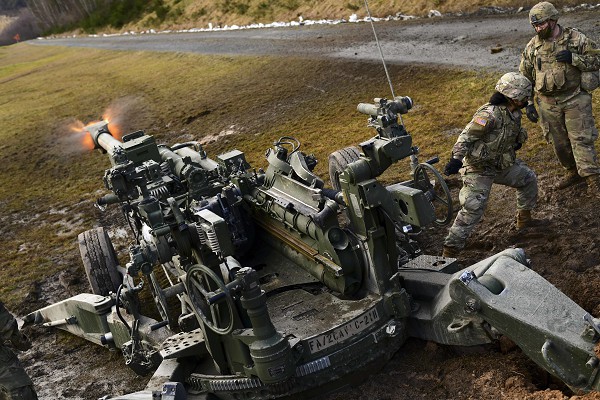 In this U.S. Army photo by Kevin Payne, 1st Lieutenant Nancy Gomez fires an M777 Howitzer during direct fire exercises at Grafenwoehr Training Area, Germany. The “Triple Seven” uses Excalibur rounds; a 155mm extended range shell that uses a jam-resistant internal GPS receiver to guide it to its target and is accurate to within 30 feet.
In this U.S. Army photo by Kevin Payne, 1st Lieutenant Nancy Gomez fires an M777 Howitzer during direct fire exercises at Grafenwoehr Training Area, Germany. The “Triple Seven” uses Excalibur rounds; a 155mm extended range shell that uses a jam-resistant internal GPS receiver to guide it to its target and is accurate to within 30 feet.
Grafenwoehr Training Area, Germany. (August 2, 2022): First you see a flash. Then comes a rumbling beneath your feet until the thunderous explosion rattles your entire body. Ears ringing, gun smoke fills the air as the next round heads down range with similar ferocity. The first thought that comes to mind is “Dear God, it must be awful to be on the receiving end of that.”
Anyone who has witnessed American artillery can attest to its awesome, almost life altering, power. When the Russians invaded, little did they realize their troops would be on the “receiving end” of American might, wielded by a brave and determined Ukraine.
This war has evolved into a long-range artillery duel which has, until now, favored the Russians.
HIMARS changed all that.
Today’s modern artillery systems are the product of centuries of development and experimentation going back to the invention of gun powder in 142 A.D. For centuries, man has attempted to use firepower to gain an edge on the battlefield. It wasn’t until the 14th Century that armies fashioned cannons out of brass or bronze that were mounted on two-wheeled carriages that revolutionized the field of artillery. Later advancements in gun powder and the advent of steel barrels increased the accuracy and lethality of artillery.
Today, artillery rounds are encased in brass shells and ranked as either Light (up to 105mm) to support ground troops, Medium (105mm to 155) to bombard targets, and Heavy (155mm plus) for attacking rear installations.
America’s next generation U.S. Army artillery is the M777 Howitzer and its precision-guided munitions that have transformed the field of artillery. The “Triple Seven” uses Excalibur rounds; a 155mm extended range shell that uses a jam-resistant GPS receiver to guide it to its target and is accurate to within 30 feet. The round contains an internal navigation system that provides in-flight guidance dramatically improving accuracy and lessening collateral damage.
Here’s how it works.
First, the target location is entered into the projectile’s mission computer using what’s called an Enhanced Portable Inductive Artillery Fuse Setter. Once programmed, the round uses an internal jam-resistant GPS receiver to guide the munition to its target. Each round has three fuse options (point-detonation, delay, or height of burst) and is employable in all weather conditions and terrain. The Excalibur’s accuracy means less collateral damage while providing maximum firepower support for troops in the field.
America’s modern cannoneers spend long hours in the field and away from their loved ones (See accompanying article on 13 Bravo) defending our freedom. Your donations for yellow ribbon care package troop support boosts the morale of active duty deployed service members like these worldwide. Please join the Patriot Brigade® and make a monthly recurring pledge to ensure we can continue giving care and assistance to active-duty military and their families at https://supportourtroops.org/donate.


